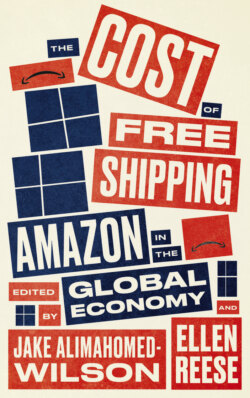Читать книгу The Cost of Free Shipping - Группа авторов - Страница 10
На сайте Литреса книга снята с продажи.
Preface Amazon and the Future of Work
in the Global Economy Ruth Milkman
ОглавлениеJeff Bezos, now the world’s richest individual, launched Amazon as an online bookstore in 1995. Over the next quarter-century it grew into an e-commerce behemoth, offering rapid home delivery of an ever-expanding range of products and services—from A to Z, as its logo promises; its 2017 acquisition of Whole Foods made it a major player in food delivery as well. Critical to Amazon’s business model are its massive warehousing and logistics operations; its cloud computing division is also a key profit center. The COVID-19 pandemic accelerated the spectacular growth of what this book’s editors call “Amazon capitalism,” as demand for home delivery surged while countless brick-and-mortar retailers were forced to close.
Even before the unexpected pandemic bonanza, Amazon’s market value exceeded that of any other corporation on earth, displacing Walmart (still the world’s largest private-sector employer) as the icon of corporate domination and labor exploitation. The two giant firms have much in common: massive market power predicated on streamlined supply chains, which in turn provides leverage to extract lower prices from manufacturers and vendors, and to deploy predatory pricing to undercut competition from other retailers. And like Walmart, Amazon is intransigently anti-union.
Amazon pays hourly workers a bit better than Walmart does, in part because Amazon needs fewer of them. It runs only a few retail outlets and makes extensive use of robotics and other forms of automation in its “fulfillment centers.” Yet, as this book chronicles in rich detail, Amazon’s warehouses in many respects resemble the factories of the past: workers are subject to the daily indignities, productivity pressures, and health and safety hazards long associated with manufacturing. The company also relies on an army of “last mile” delivery workers, often hired by subcontractors, who rush goods to customers’ homes a day or two after online orders are placed, or sometimes within hours. In these sweatshops on wheels, as in the warehouses, old-style labor exploitation is intensified by high-tech worker surveillance, algorithmic management, gamification, and automation.
The chapters that follow document Amazon’s impact outside the workplace as well as inside it. One focus is the systematic surveillance of customers, not only monetizing data from their online purchases but also tracking more intimate behavior through in-home devices like Alexa. Another theme is the destructive environmental impact of Amazon warehouses, which sharply increase truck traffic, air pollution, and respiratory illnesses in the areas where they are located. Yet cities and states compete fiercely to lure Amazon facilities to their jurisdictions, offering tax breaks and other incentives— unaware that, as Juliann Allison suggests in this volume, such concessions tend to neutralize any economic development benefits.
In the United States, where a stunning 60 percent of households are Amazon Prime members, the company has amassed a vast base of loyal customers, and it is increasingly replicating that success in other countries. Most customers relate to Amazon simply as a convenient and affordable place to shop, oblivious or indifferent to the catalogue of ills this book reveals. They are even less likely to be aware of the labor and community organizing efforts that aim to challenge Amazon’s vast power on multiple fronts, also chronicled here.
The most successful struggles to date have unfolded in Western Europe, where labor unions have made significant inroads. Amazon workers in Germany, Poland, France, Italy, and Spain launched a series of strikes in the 2010s, winning significant concessions; an international “Amazon Alliance” of unions involved in these efforts has grown to include 15 countries. In the United States, where obstacles to unionism are especially formidable, such efforts have been more elusive. Once again, there is a Walmart echo: after spending millions of dollars on a decades-long series of campaigns to organize Walmart workers, the United Food and Commercial Workers accepted defeat in 2015. That bruising experience, along with other setbacks for U.S. organized labor in recent years, help explain the lack of any major union resource commitments to Amazon organizing in the company’s home country.
Nevertheless, a few notable efforts have emerged. The first breakthrough was a 2018 work stoppage at an Amazon warehouse in Minneapolis, led by Somali workers demanding Muslim prayer rights. Its success helped stimulate the formation of Athena, a national coalition coordinating Amazon-focused organizing across the nation. Separately, New York City unionists’ insistence that Amazon maintain neutrality vis-à-vis future union organizing efforts in that city contributed to the collapse of the controversial plan to locate an Amazon “HQ2” in Long Island City in 2019. That same year, Amazon’s tech workers, led by progressive Millennials, staged a walkout demanding that the company aggressively combat climate change and stop providing services facilitating federal immigration enforcement. Finally, against the background of the COVID-19 pandemic, workers protested the lack of personal protective equipment at Amazon warehouses in walkouts across the U.S. in the spring of 2020.
So far, these efforts have had little impact on the Amazon juggernaut, which continues to gain momentum in the United States and worldwide. But for those who hope to change that, the probing studies by labor and urban scholars collected in this book provide an invaluable resource.
